Touchscreen classification underwent significant changes in 2017—firstly, a new subheading 8548.9000 30 “Touch-sensitive data input devices (i.e., touchscreens) …” was added at the beginning of the year; secondly, the classification decision “Touchscreen Z2008-0069” was abolished in the General Administration of Customs announcement No. 17 of 2017 in the first half of the year.
These changes have brought about new issues—what types of touchscreens are included in the new subheading 8548.9000 30? What was the reason for abolishing the classification decision “Touchscreen Z2008-0069”? Where should this product be classified after the abolition?
This article will provide a detailed analysis and discussion of the above questions after introducing relevant knowledge about touchscreens.
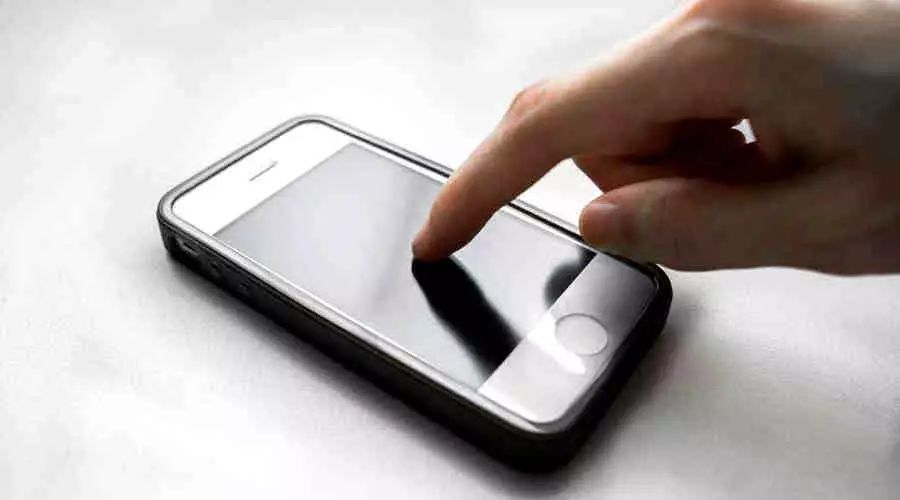
A touchscreen is an input device that allows users to perform certain operations by directly touching the display with fingers or other touch-sensitive mediums, mainly used to replace existing mice and keyboards. Early touchscreens were primarily used in computer monitors, and later gradually expanded to devices like ATMs, video game consoles, electrical control panels, public information inquiry platforms, and smartphones.
Touchscreens can be classified based on their working principles into resistive (resistive technology), capacitive (capacitive technology), surface acoustic wave (surface acoustic wave technology), and infrared (infrared technology). Currently, resistive and capacitive touchscreens are the most widely used.
A complete touchscreen mainly consists of hardware components and software parts. The hardware part includes the touch sensor and touchscreen controller; the software part refers to the touchscreen driver.
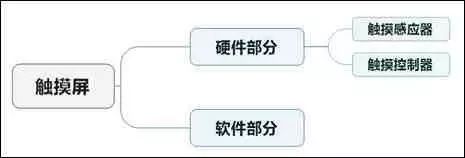
Components of a Touchscreen
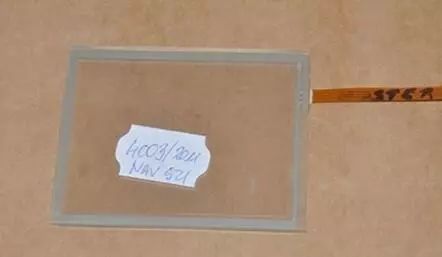
Touch Sensor
It should be noted that what we commonly refer to as a touchscreen is specifically the touch sensor, which is the narrow definition of a touchscreen (hereafter, “touchscreen” refers to this narrow definition). The broad definition of a touchscreen includes the complete touchscreen with the touch controller.
The function of the touch sensor is to detect the user’s touch position and transmit it to the touch controller, usually installed in front of the display panel. The role of the touch controller is to receive touch information from the touch sensor, convert it into touch coordinates, and send it to the CPU, while also receiving commands from the CPU and executing them. The touchscreen controller is typically a small microcontroller chip installed within the display.
Resistive Touchscreen
A resistive touchscreen mainly consists of two layers of transparent ITO (Indium Tin Oxides) conductive layers, separated by insulating spacers, with a glass base layer at the bottom and a plastic protective layer at the top. Therefore, a resistive touchscreen has a total of five layers: protective layer, upper conductive layer, spacer layer, lower conductive layer, and glass layer.
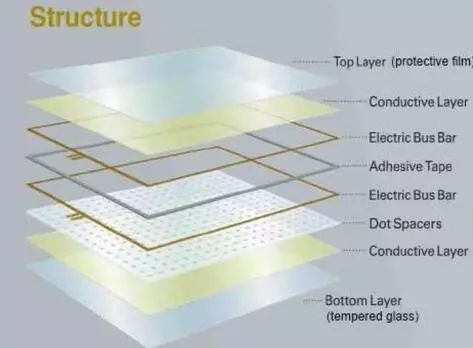
Structure of Resistive Touchscreen
The working principle of a resistive touchscreen—when a finger touches the screen, the two separated conductive films make contact at the touch point, causing a short circuit between the two conductive films, and the change in voltage at this moment is measured to calculate the touch position. In other words, the touchscreen converts the physical position of the touch point (X, Y) in a rectangular area into voltages representing the X and Y coordinates.

Working Principle of Resistive Touchscreen
Capacitive Touchscreen
A capacitive touchscreen mainly consists of two layers of transparent ITO conductive layers, separated by glass or optical transparent glue, with a glass protective layer on the outermost layer. A capacitive touchscreen has a total of five layers: glass protective layer, optical transparent glue layer, upper conductive layer, optical transparent glue layer, and lower conductive layer.
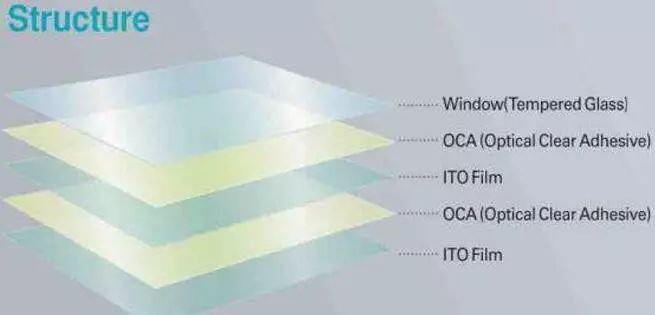
Structure of Capacitive Touchscreen
The working principle of a capacitive touchscreen—when a finger touches any position on the sensing screen, the electric field of the human body forms a coupling capacitor with the surface of the touchscreen. For high-frequency currents, the capacitor acts as a direct conductor, causing a small current to be drawn away from the contact point. This current flows from the electrodes at the four corners of the touchscreen, and the current flowing through these four electrodes is proportional to the distance from the finger to the corners. The touchscreen controller calculates the touch point’s position by accurately computing the ratio of these four currents.
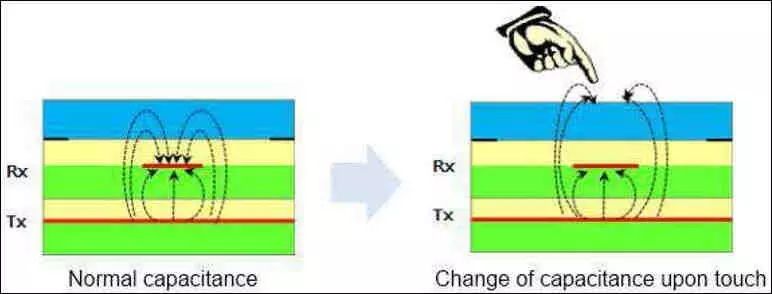
Working Principle of Capacitive Touchscreen I
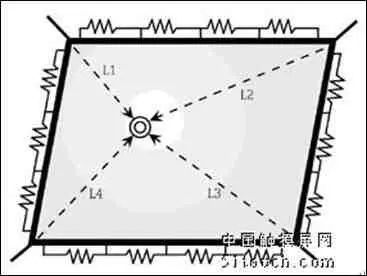
Working Principle of Capacitive Touchscreen II
Surface Acoustic Wave Touchscreen
A surface acoustic wave touchscreen consists of a transmitter transducer, a receiver transducer, a reflector, and a controller. This is a broad definition of a touchscreen, where the touchscreen part is merely a piece of transparent reinforced glass, with no covering layer on the glass surface. The three corners of the touchscreen are equipped with transmitters and receivers for X and Y direction sound waves, and the four edges are engraved with reflective stripes for ultrasonic reflection (i.e., reflector).

Composition Structure of Surface Acoustic Wave Touchscreen
The transmitter transducer converts the 5.53MHz electrical signal from the controller into surface acoustic waves with a wavelength of about 500μm, which propagate in a straight line across the screen. The receiver transducer is responsible for receiving the sound wave signals reflected back from the reflector in both X and Y directions and outputs the received sound wave signals to the controller.
The working principle of the surface acoustic wave touchscreen—when not touched, the waveform of the received signal is exactly the same as the reference waveform; when a finger or another object that can absorb or block surface acoustic wave energy touches the screen, some sound wave energy is absorbed, creating a decay notch in the received waveform. The controller analyzes the decay of the received signal and determines the X and Y coordinate values based on the position of the notch.
Infrared Touchscreen
An infrared touchscreen is equipped with a circuit board frame installed in front of the display, with infrared emitters mounted along the left side (Y-axis) and the bottom (X-axis) of the frame, and corresponding receivers on the opposite sides, forming a cross infrared matrix. This product is named a touchscreen, but it does not contain a screen itself.

Composition Structure of Infrared Touchscreen
The working principle of the infrared touchscreen—an infrared touchscreen detects and locates the user’s touch position using a dense infrared matrix in the X and Y directions. When a finger touches the screen, it blocks the intersecting infrared rays at that position, allowing the touchscreen to determine the X and Y coordinate positions of the touch point.
Human-Machine Interface
A Human-Machine Interface (HMI) is a device that allows users to issue commands to machines through a certain interface, and the machine can also use this interface to provide feedback on execution status and system status to the user.
The HMI consists of hardware and software components. The hardware part includes processors, display units, input units (such as touchscreens), communication interfaces, data storage units, etc.; the software part refers to the system’s driver programs and system software. HMIs are typically used in automatic control systems for machines.
In other words, a touchscreen is a component of a human-machine interface.
Touchscreen
A touchscreen is merely a hardware component that may be used in a human-machine interface, serving as an input device installed in front of the display to replace some functions of the mouse and keyboard.
Display Device
A display device is the display equipment behind the touchscreen, such as an LCD screen.
Since touchscreens are generally used over LCD screens, they are sometimes declared as “touch control screens” during actual inspections, which actually refers to a combination of touchscreen and LCD screen, possessing both touch and display functions. Therefore, if the structure of the touchscreen is not understood, the operators may easily confuse a “touchscreen with a display” as just a touchscreen.
Currently, most touchscreens are placed over displays, referred to in the industry as on-cell touchscreens. With technological advancements, some smartphones have integrated touchscreens within the displays, known as in-cell touchscreens, where the touchscreen controller chip and display chip are integrated into one large chip.
Based on the function and principle of touchscreens, they are classified as data input devices, specifically X-Y coordinate input devices, which clearly aligns with the notes in Chapter 84, note 5(3) and the notes for item 84.71 that mention “touch-sensitive screens,” particularly where note 5(3) explicitly states that “X-Y coordinate input devices can be classified under item 84.71 as long as they meet the conditions set in notes 5(3)2 and 5(3)3.” In other words, X-Y coordinate input devices can still be classified under item 84.71 even if they do not meet the conditions of note 5(3)1, meaning they are not exclusively or primarily used for automatic data processing systems. Therefore, when encountering touchscreen classifications, they can undoubtedly be classified under subheading 8471.6 as “input components.”
However, touchscreen classification is not as straightforward as we might think; not all touchscreens can be classified under item 84.71. For example, the classification decision published by the WCO states that touchscreens specifically for mobile phones are classified as components for communication devices under subheading 8517.7 (see example one below). This indicates that the “X-Y coordinate input devices” referred to in notes 5(3) of Chapter 84 and the notes for item 84.71 must meet certain conditions.
The notes for item 84.71 describe “X-Y coordinate input devices” as “components that input position data into automatic data processing devices. They include mice, light pens, joysticks, trackballs, and touch-sensitive screens, all sharing the common feature of displaying data related to a fixed point as input (or interpreted as input), and their common purpose is to control the position of a cursor on the display component to replace or assist the keyboard cursor keys.”
The author believes that the devices listed above, such as mice, light pens, joysticks, and trackballs, can independently perform their functions through corresponding interfaces (e.g., USB interface, RS-232 interface), and the “touch-sensitive screen” mentioned here should also have independent functionality. In other words, only a “complete touchscreen” that includes both the touch sensor and the touch controller can be classified under item 84.71; the narrow definition of a “touchscreen” that only includes the touch sensor cannot independently achieve information input functionality and cannot be classified under item 84.71.
Additionally, under note 5(3) of Chapter 84, it is stated that X-Y coordinate input devices can still be classified under item 84.71 even if they do not meet the conditions of note 5(3)1—so, does a “complete touch-sensitive screen” consisting of a mobile phone touchscreen and touch controller belong under item 84.71 as an X-Y coordinate input device?
From the classification decisions that have been published (see example one, transparent capacitive touchscreen for mobile phone W2016-044), it can be seen that the WCO does not consider it an “X-Y coordinate input device.” If the complete touchscreen for mobile phones were classified under item 84.71, then the mobile phone touchscreen should be classified as a specific part of the complete touchscreen under item 84.73. Ultimately, the WCO classified the mobile phone touchscreen as a specific part of the mobile phone under subheading 8517.70.
From the above analysis and the relevant classification decisions that have been published, the classification of products like “touchscreens” can be summarized as follows—Touchscreens specifically designed for certain electronic devices should be classified as specific parts; when it cannot be determined that they are for a specific electronic device but are general for multiple electronic devices, they should be classified under item 85.48 as parts of electrical devices not otherwise specified; touchscreens used in human-machine interfaces for control systems should be classified under item 85.37 as control devices; touchscreens that come with displays (i.e., a combination of display and touchscreen) should be classified as specific parts.
Product: Transparent capacitive touchscreen for mobile phone W2016-044. The product measures 56mm x 109mm x 1.3mm and includes two transparent ITO conductive layers and a tempered glass protective layer (top layer), bonded together by optical transparent glue. The screen also has a flexible printed circuit board with a touch integrated circuit. When touched, the static electric area formed by the ITO conductive layer reacts to the natural current of the human body, causing deformation. The touch integrated circuit senses the deformation of the static electric area, calculates the position of the touch, and transmits the information to the mobile phone’s application processor. The touchscreen itself does not have display functionality.
The screen is used together with the mobile phone LCD screen or active matrix organic light-emitting diode display device (AMOLED). The four corners of the screen are rounded and have reserved positions for the mobile phone’s main key, camera lens, and a speaker.
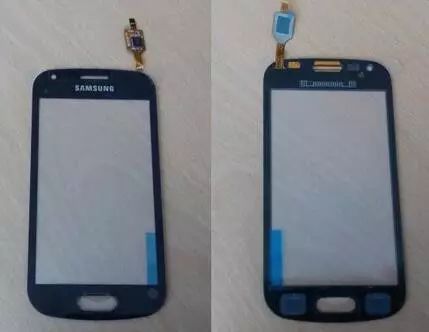
Transparent Capacitive Touchscreen for Mobile Phone
Classification: Classified under subheading 8517.70 according to general classification rules one [note 16(2)(2) and 6].
Comment: This touchscreen is a capacitive touchscreen that only includes the touch sensor and does not include the touchscreen controller. It belongs to the narrow definition of a touchscreen and cannot independently achieve information input functionality, so it cannot be classified under item 84.71.
Product: AMOLED touchscreen for mobile phone. This product consists of an AMOLED display panel, a cover glass, and a flexible printed circuit assembly, with a screen size of 5.3 inches (width 75.8mm, height 123.3mm, thickness 1mm). The display panel contains two layers of ITO semiconductor conductive film, enabling capacitive touchscreen operation.
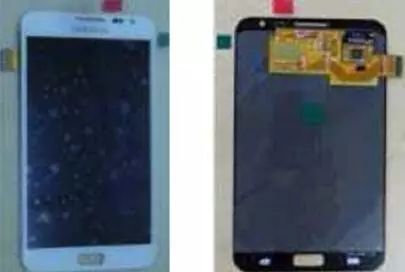
AMOLED Touchscreen for Mobile Phone
Classification: This product contains two layers of ITO semiconductor conductive film, with the touchscreen made within the display, classified as an in-cell touchscreen, which is a combination of touchscreen and display device, possessing both touch and display functionalities. This product exceeds the scope of a touchscreen; as a combined product, it cannot independently achieve display and touch functionalities and is considered a specific part for mobile phones, thus classified under subheading 8517.7030 according to general classification rules one [note 16(2)(2) and 6].
Comment: This product is declared as a “touchscreen,” similar to example one, but example one only includes the touchscreen, while this example is a combined product of touchscreen and display.
Product: Touchscreen. This touchscreen is available in various specifications including 12.1 inches, 15.0 inches, and 15.1 inches, and is a four-wire resistive touchscreen. Its working principle is to find the coordinate axis using voltage drop, with each axis driven by a pair of 0-5 volt signals. When this resistive touchscreen is pressed, the circuit is completed, resulting in a voltage drop. The controller calculates the proportion of the voltage drop and converts it into a digital signal, which is then sent to the CPU, which operates in a manner similar to a mouse to calculate the coordinates and instructs the graphics card to output the corresponding position through the display. This type of touchscreen can be used in various self-service inquiry systems, automatic sales systems, and financial withdrawal and transfer systems.
Classification: This product is the same as the abolished classification decision (touchscreen Z2008-0069), which only includes the touch sensor and does not include the touchscreen controller, thus cannot achieve independent information input functionality and does not belong under item 84.71 as “touch-sensitive screen.” It is used across various self-service inquiry systems, automatic sales systems, and financial withdrawal and transfer systems, and is not specific to any one device, so it cannot be classified as a specific part but rather as a part of electrical devices not otherwise specified, classified under subheading 8548.9000 30 according to general classification rules one [note 16(2)(3) and 6].
Comment: The author believes that the reason for abolishing this classification decision is that it contradicts the classification decision published by the WCO (transparent capacitive touchscreen for mobile phone W2016-044). After the abolition of this classification decision, this product should be classified under subheading 8548.9000 30.
Product: 15.6″ touchscreen LCD display board. This product consists of an LCD panel, backlight source, control circuit, and touchscreen, with touch functionality that allows for screen switching, data on-demand, and function adjustment for color LCD TVs.

15.6″ Touchscreen LCD Display Board
Classification: This product is a component of a color LCD television, consisting of an LCD panel, backlight source, control circuit, and touchscreen. The function of the control circuit is to calculate the position of the image being cut and determine the exact position being touched, transmitting this precise position information to the CPU. The product functions as an LCD display board with touch functionality, and according to general classification rules one and six, it should be classified as a specific part of a television under subheading 8529.9081.
Comment: This product is a combination of touchscreen and LCD display board, with control circuit and other components, which exceeds the scope of a touchscreen. The combined product cannot work independently and has specific functions, thus classified as a specific part of a television.
Product: Human-Machine Interface. This product mainly consists of four parts: touchscreen display, mainboard, communication interface, and power board. Its main functions are to display the process flow and process parameters during production, show alarms and fault information; monitor process equipment and operational status, and operate and set process parameters through the touchscreen; communicate with programmable controllers to complete data collection, analysis processing, and transmission functions. It is mainly used in the operation layer of DCS.
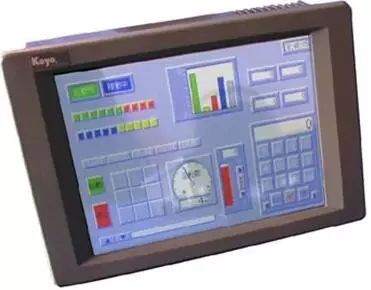
Human-Machine Interface
Classification: This product is an electrical control device composed of a touchscreen and other hardware, meeting the description of item 85.37, and according to general classification rules one and six, should be classified under subheading 8537.1090 as other electrical control devices.
Comment: This product is a human-machine interface composed of a touchscreen and other components, with the primary function of electrical control, classified based on the main function of the product.

Note: The above content represents the author’s personal views; any inaccuracies are welcome for correction.
References
[1] Zhou Zhimin. Illustrated Touchscreen Engineering Application Techniques [M]. Beijing: Mechanical Industry Press, 2015.
[2] Wang Haisheng. Design and Implementation of an In-Cell Touch Control LCD Screen [D]. University of Chinese Academy of Sciences, 2017.

Author: Wen Chaozhu, Shanghai Customs College
Editor, Publisher: Gao Yang

